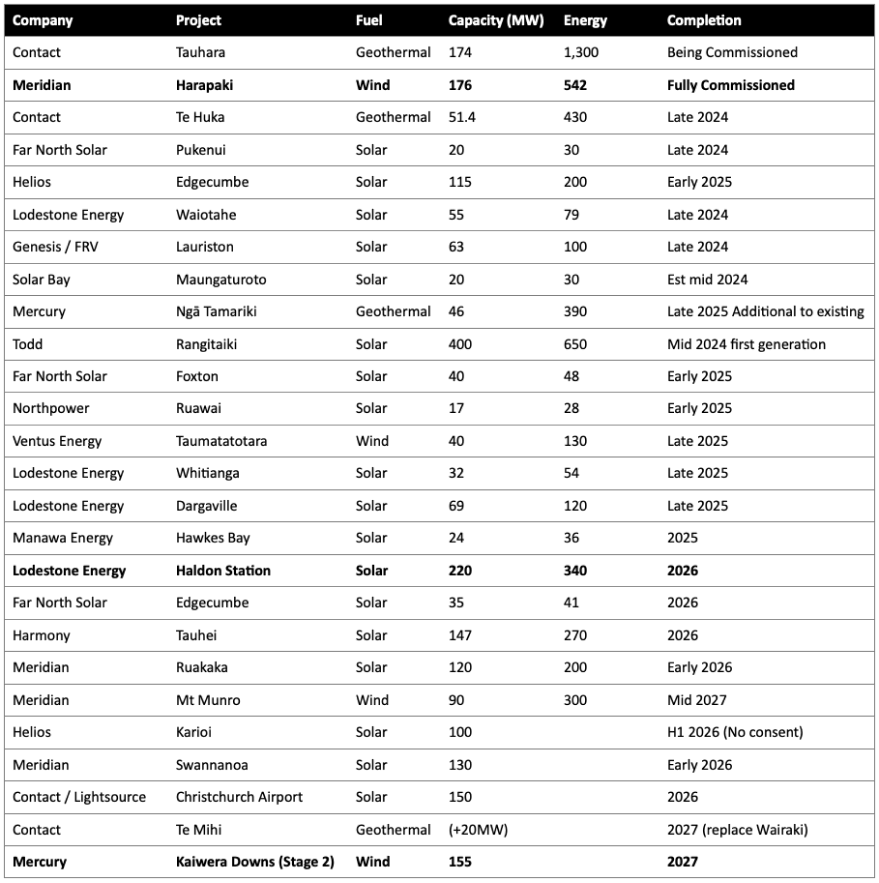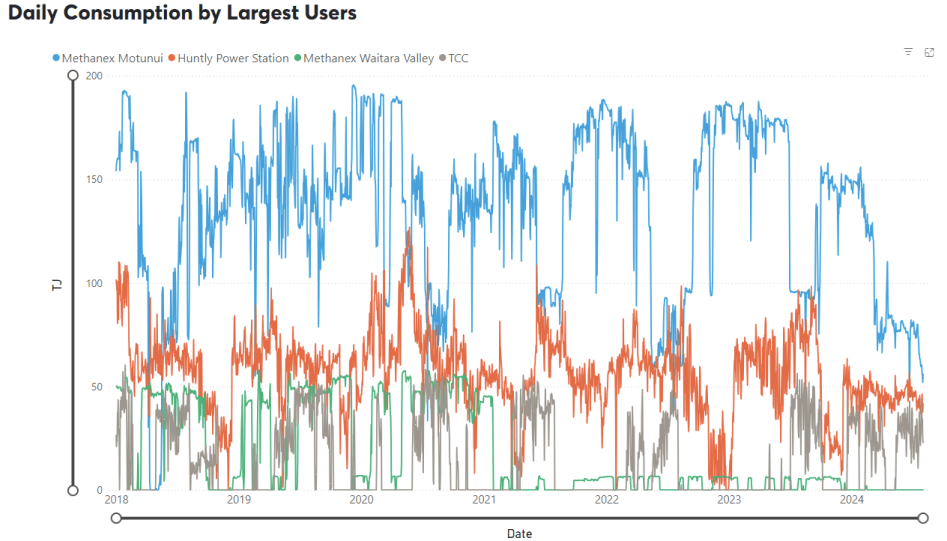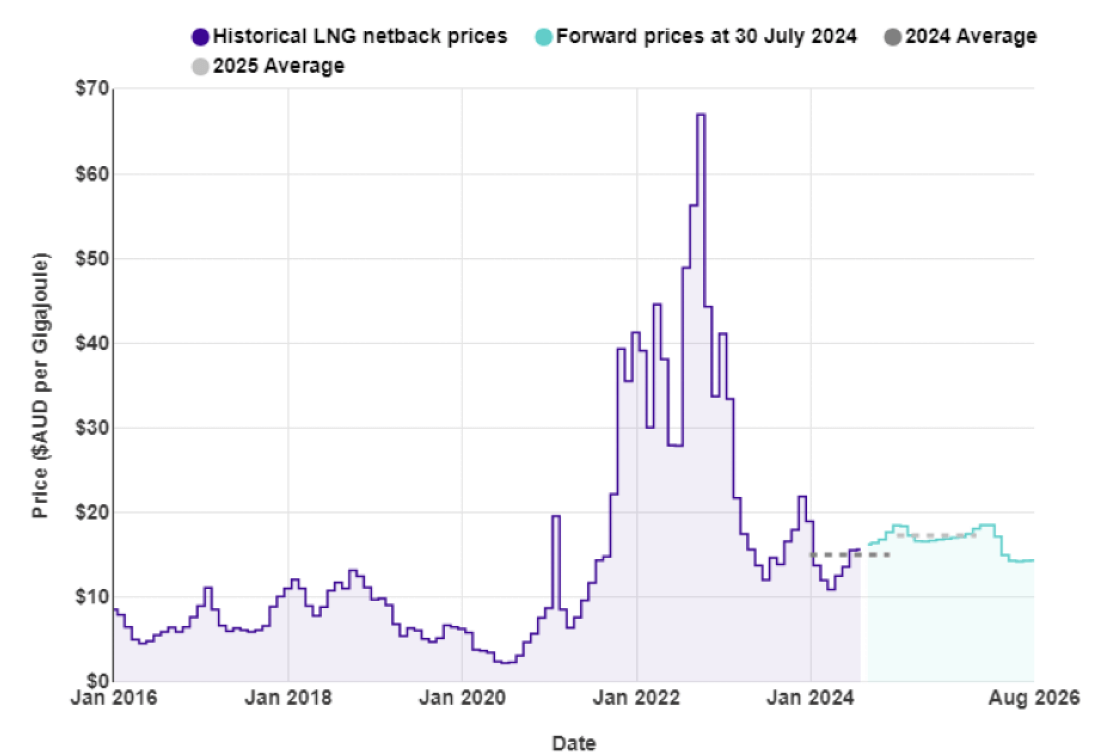Market Update July 2024
The Wholesale Electricity Market
Spot prices in the wholesale electricity market increased markedly in July from their already very high levels. Average spot prices ranged from $338 in the central North Island (up from $248 in June), up to $414 in the upper South Island (up from $286).

The following chart shows average weekly spot prices over the last 2 years. July’s significant increases can be clearly seen.

Electricity Demand
Electricity demand through July was variable with higher levels corresponding to some cold spells, before returning to more “normal” winter levels of demand.

Electricity Generation Mix
Through July the generation mix saw even more thermal power running to try to conserve hydro as much as possible given the level of demand.

HVDC Transfer
Power transfers on the HVDC link connecting the North and South Islands are important both in showing relative hydro positions and the reliance on thermal power to meet demand. High northward flow tends to indicate a good SI hydro position, whereas the reverse indicates a heavy reliance on thermal power to make up for hydro shortages.
July saw further attempts to conserve South Island storage by reducing northward transfer and increasing southward transfer. Net transfers for the month were southward – something not seen very often.

The Electricity Futures Market
The Futures Market provides an indication of where market participants see the spot market moving in the future. They are based on actual trades between participants looking to hedge their positions (as both buyers and sellers) into the future against potential spot market volatility. They are also a useful proxy for the direction of retail contracts.
The following graph shows Futures pricing for CY 2024, 2025, 2026 and 2027 at Otahuhu (Auckland) for the last 2 years.

Note that $100/MWh equates to 10c/kWh.
Forward prices were up in July for all future years, but particularly CY2025. This ended the month up 30% at $259. CY 2026 price was up 2% at $174 while CY 2027 closed up 4% at $167.5/MWh.
Known new generation projects are shown below (additions / removals / changes highlighted in bold).

Hydro Storage
Inflows were very low across both the North and South Island during July, following on from already very low inflows particularly in the South Island this year to date.

These very low inflows resulted in energy storage levels continuing to fall through July. NZ storage ended the month at 1,705GWh or 37% full, down 477GWh. The following chart shows the latest breakdown of storage across the main hydro catchments.

Security of supply risks increased further in July with storage levels decreasing. This is shown in the following risk curves.

Snowpack
Snowpack is an important way that hydro energy is stored over the winter months and released as hydro inflows in the spring. The following graph shows that the snowpack in the important Waitaki catchment is currently close to the minimum levels seen in the last 30 years for this time of year.

Climate outlook overview (from the MetService)
Climate drivers — El Niño Southern Oscillation (ENSO) remains neutral, and should remain this way through the rest of winter and into the first part of spring, with the most influential climate drivers originating closer to home.
The Southern Annular Mode (SAM), a measure of how far north or south strong westerlies lie in the Southern Ocean, trends slightly positive for the first half of August as high pressure shifts northeast across New Zealand, with below average rainfall most likely to occur from central North Island southwards towards eastern South Island. The Tasman Sea Index (TSI) is also a good indicator – this is currently slightly negative, which denotes lower pressure and increased rainfall across parts of the upper North Island, but there are hints this also turns positive next week. Some uncertainty remains within the weather models as to how strongly and quickly these indicators shift back to negative territory, and there is a risk that western regions trend slightly wetter during the first two weeks of August.
The back half of August is likely to see both SAM and TSI remain in a more negative regime as high pressure moves eastwards, paving the way for an influx in westerly weather makers to spread across New Zealand. In the longer-term, there remains a heightened chance of a La Niña developing later this spring, with effects most likely to be felt during the summer months.
August 2024 Outlook — A Tasman low brings a burst of rain across the upper North Island over the coming days, while the remainder of the country remains notably drier as strong high pressure builds northwards. This low moves away later this weekend, allowing the ridge to spread elsewhere and bring a spell of dry weather most places. Another low pressure system makes its presence known by the middle of next week across southern South Island, though temperatures may remain too warm for another low-level snow event in the prevailing northwesterly flow. Soils are currently near saturation across most regions, but expect to see soil moisture content decrease from central North Island down to eastern South Island over the coming week.
The second week of August sees the ridge weaken and shift over the North Island, while a more active northwesterly pattern emerges over the South Island. A quick-moving front or two is likely to spread across the South Island with near-average rainfall picked, and these may progress further north depending on how quickly the ridge weakens. Temperatures are expected to remain a bit warmer than average, particularly across eastern and southern South Island.
A broad area of low pressure spreads across New Zealand during the final two weeks of August, bringing with it an increased chance for weather makers to spread over the country. While models are currently picking near-average precipitation country-wide, there is a risk that western and southern regions see increased amounts in a windier westerly pattern. This includes an increased possibility for late winter cold snaps and mobile westerly snow makers as long as New Zealand remains under a cooler Southern Ocean influence.

The Wholesale Gas Market
Spot gas prices in July increased even further from the already very high levels seen in June, averaging $35/GJ. Wholesale prices are 300% higher than they were at the same time last year.

We have seen signs that gas retailers are refusing to offer contracts to end users even where they are the incumbent retailer. Some tenders are getting no offers at all from retailers. Nothing of any substance has come from the Government appointed Gas Security Response Group.
Smart Power has been able to source some gas for clients who are approaching the end of their current contracts. If you are in a similar position, please contact us and we will see what we can do to assist you.
On the supply side most fields managed to maintain output levels from last month. Maui even managed a small increase – up around 5% to close to 80TJ/day. Pohokura maintained output at around 43TJ/day. McKee / Mangahewa had a period of reduced output in the middle of the month but rebounded to just above 50TJ/day at the end of the month. Kupe maintained around 46TJ/day through the month
The following graph shows production levels from major fields over the last 6 years.

On the demand side, Methanex Motonui’s continued to largely provide the buffer for the reduced supply. Usage decreased to almost 50TJ/day by the end of July – down from 80TJ/day at the start of the month. Huntly power station decreased, averaging 42TJ/day, while TCC continued its extended running since May, averaging close to 30TJ per day during July.
The following graph shows trends in the major gas users over the last 6 years.

Internationally, LNG netback prices ended the month flat at $15.65/GJ – up 0.5% from last month. Forecast prices for 2024 increased to $15.04 – up 0.5% compared to June. Forecast prices for 2025 were up 4% at $17.32/GJ. (Note that netback prices are indicative of international prices – they are produced by the ACCC and quoted in Australian dollars. They are net of the estimated costs to convert from pipeline gas in Australia to LNG, hence the term “netback”).

New Zealand does not have an LNG export market, so our domestic prices are not directly linked to global prices.
LPG is an important fuel for many large energy users, particularly in areas where reticulated natural gas is not available. The contract price of LPG is typically set by international benchmarks such as the Saudi Aramco LPG – normally quoted in US$ per metric tonne.
The following graph shows the Saudi Aramco LPG pricing for the last 3 years as well as forecast pricing for the year ahead. There has been a decrease in futures pricing over the last month.

The other main contributing factor to LPG prices in New Zealand is the exchange rate against the USD. There has been a significant drop in recent times which will put upward pressure on NZ LPG pricing.

The Coal Market
The global energy crisis has been as much about coal as it has gas. The war in the Ukraine has driven energy prices, including coal, up. Prices in July were up, ending the month at US$140/T – a 6% decrease on the June close. These prices are finally returning to levels close to what we expect to see as shown in the following graph of prices over the last 10 years.

Like gas, the price of coal can flow through and have an impact on the electricity market. This month Genesis reported that it had imported additional coal. Stockpiles had reduced to 231,000 tonnes at the end of June – down from 624,000 tonnes at the end of March. Genesis says that it usually aims to hold about 350,000 tonnes of coal.
Carbon Pricing
NZ has had an Emissions Trading Scheme (ETS) in place since 2008. It has been subsequently reviewed by several governments and is now an “uncapped” price scheme closely linked to international schemes. However, there are “upper and lower guard-rails” set up to prevent wild swings in carbon price that act as minimum and maximum prices. These increased in December 2023 to $173 and $64 respectively. Carbon prices increased 3% in July to $53.4.

As the carbon price rises, the cost of coal, gas or other fossil fuels used in process heat applications will naturally also rise. Electricity prices are also affected by a rising carbon price. Electricity prices are set by the marginal producing unit – in NZ this is currently typically coal or gas or hydro generators, with the latter valuing the cost of its water against the former. An increase in carbon price can lead to an increase in electricity prices in the short to medium term (as the marginal units set the price). A carbon price of $50/t is estimated to currently add about $25/MWh (or ~2.5c/kWh) to electricity prices. In the long term the impact should reduce as money is invested in more low-cost renewables and there is less reliance on gas and coal fired generation.
EU Carbon Permits increased marginally in July to 68 Euro/tonne – up 1%.
About this Report
This energy market summary report provides information on wholesale price trends within the NZ Electricity Market.
Please note that all electricity prices are presented as a $ per MWh price and all carbon prices as a $ per unit price.
All spot prices are published by the Electricity Authority. Futures contract prices are sourced from ASX.
Further information can be found at the locations noted below.
- Transpower publishes a range of detailed information which can be found here: https://www.transpower.co.nz/power-system-live-data
- The Electricity Authority publishes a range of detailed information which can be found here: https://www.emi.ea.govt.nz/
- Weather and Climate data – The MetService publishes a range of weather-related information which can be found here: https://www.metservice.com/
Disclaimer
This document has been prepared for information and explanatory purposes only and is not intended to be relied upon by any person. This document does not form part of any existing or future contract or agreement between us. We make no representation, assurance, or guarantee as to the accuracy of the information provided. To the maximum extent permitted by law, none of Smart Power Ltd, its related companies, directors, employees or agents accepts any liability for any loss arising from the use of this document or its contents or otherwise arising out or, or in connection with it. You must not provide this document or any information contained in it to any third party without our prior consent.
About Smart Power
Smart Power is a full-service Energy Management consultancy. Apart from Energy Procurement, Smart Power can also provide:
- Technical Advice on how to reduce your energy use/emissions
- Sustainability Reporting
- Invoice Management services.
We also offer boutique energy and water billing service for landlords/property developers.
Contact us at https://smartpower1.wpenginepowered.com/contact/ or ring one of our offices to talk to one of our experienced staff about how we can assist you with achieving your energy goals.
© Copyright, 2024. Smart Power Ltd